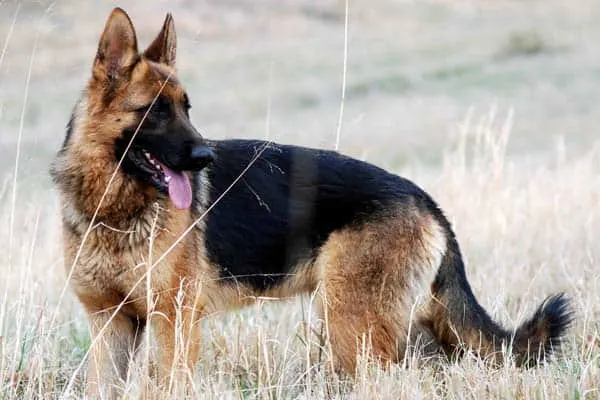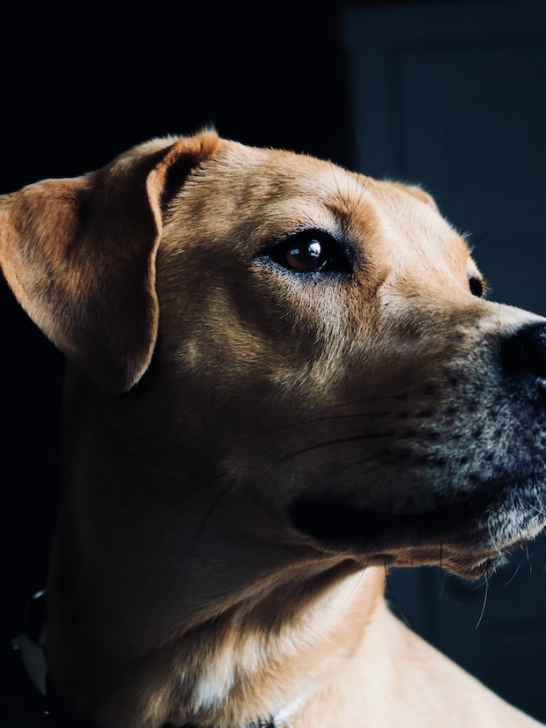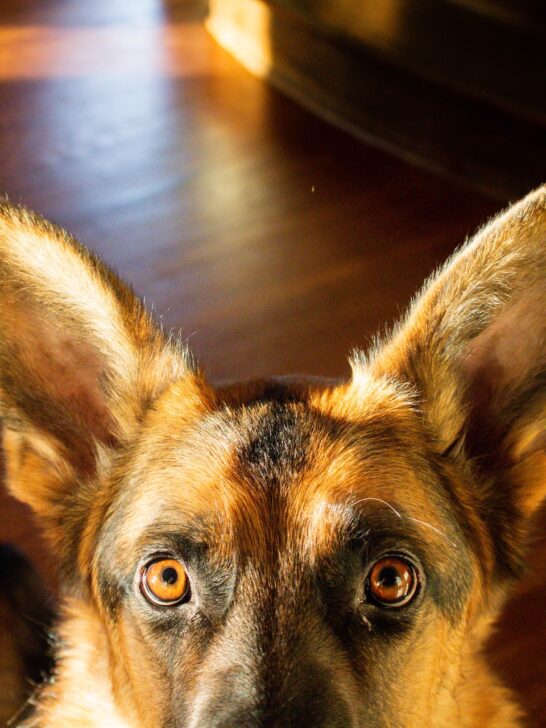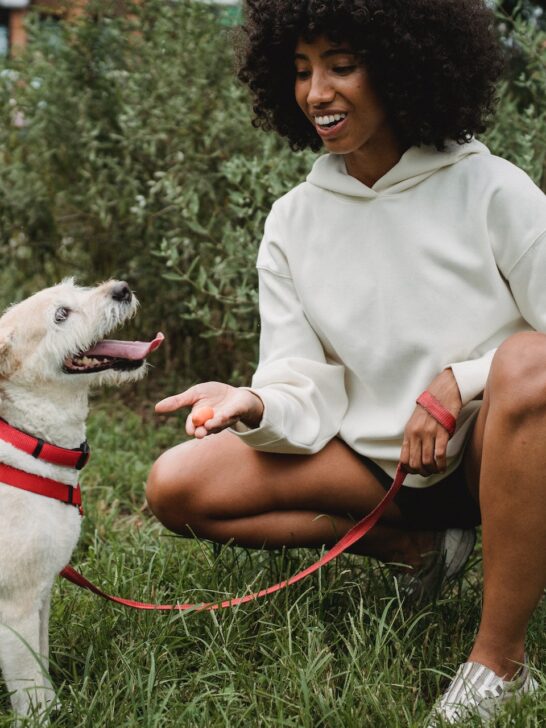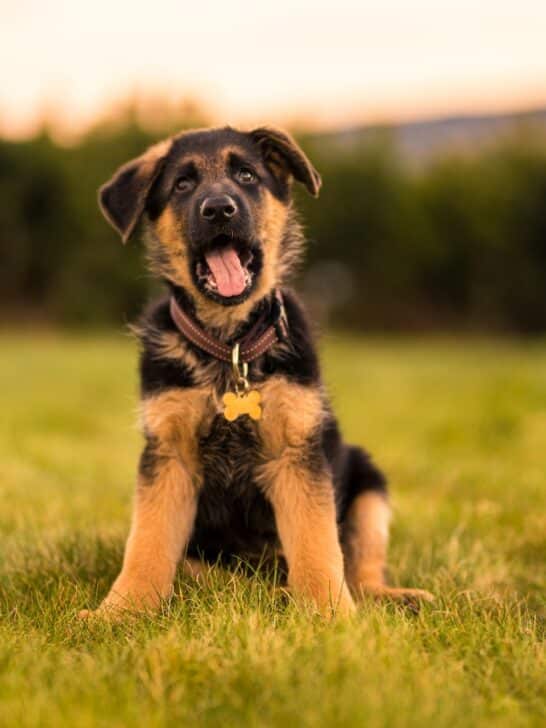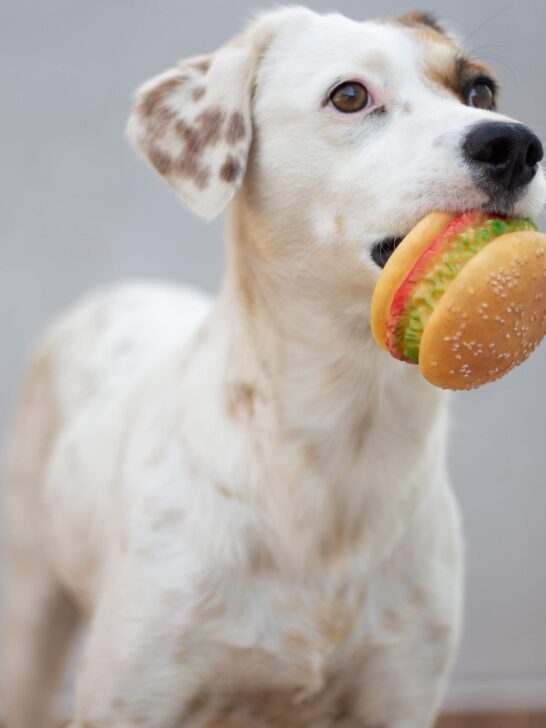Common German Shepherd Tail Problems You Need To Know About
A German Shepherd wagging its tail is saying something. According to MyGermanShepherd, it is their way of communicating.
The way they position their tail and move it means something that only their owners (and other dog owners) understand. But what if they have tail problems?
There are three known GSD tail problems, and these are mostly genetically predisposed. They are at risk of developing anal furunculosis, skin infection, and limber tail syndrome.
These conditions can be prevented by ensuring that you are breeding GSDs that are free from these diseases genetically.
The German Shepherd Tail Language
According to Allshepherd.com, when a German Shepherd moves, it conveys their feelings. Here’s what a GSD’s tail movements and positions mean:
- Wagging to the left – when a GSD is wagging its tail more to the left, it means they are feeling negative emotions such as being nervous
- Wagging to the right – when a GSD is wagging its tail more to the right, it means they are feeling positive emotions such as being excited or happy for seeing you or when playing with you
- Wagging widely on both sides – when a GSD is wagging its tail widely on both sides, it means they are very happy
- Slow wagging on both sides – when a GSD is wagging its tail slowly on both sides, it means it is being confused (notice this if you are giving your GSD training)
- The tail is in a downward position – it means your GSD is not feeling well or upset
- The tail is lowered but not hanging – it means your GSD is relaxed and is saving energy
- The tail is in between its legs – it means your GSD is afraid, anxious, or is pleading not to be hurt
- The tail is straight out or is moving high up – it means your GSD is ready to fight or is initiating a fight
- The tail is horizontally hanging low – it means your GSD is calm and is just observing its surroundings
- The tail is moving up and is curled at the tip – it means your GSD is showing confidence
In addition, Total German Shepherd explained that the way a GSD carries its tail also shows its social standing. When a German Shepherd is always holding its tail upright and stiff, it means he is the leader of the pack.
Caring For your German Shepherd’s Tail
GermanShepherdRex shared on his YouTube video how to properly trim a German Shepherd’s tail. According to him.
Most breeders and owners of GSDs don’t seem to know how to properly trim their dog’s tail hair. It is just cutting the ends of the hair, and not the tail.
Also, caring for your GSD’s tail is included in its overall maintenance. If you will brush its hair, make sure to brush its tail too.
Regularly check its anus and the skin under the tail, it is where Anal Furunculosis begins. If you notice that your German Shepherd is losing hair on its tail, and it keeps on biting it, it could be a sign of infection. Check for cuts or scrapes on the tails, it can cause infections too.
Common Tail Problems Among German Shepherds
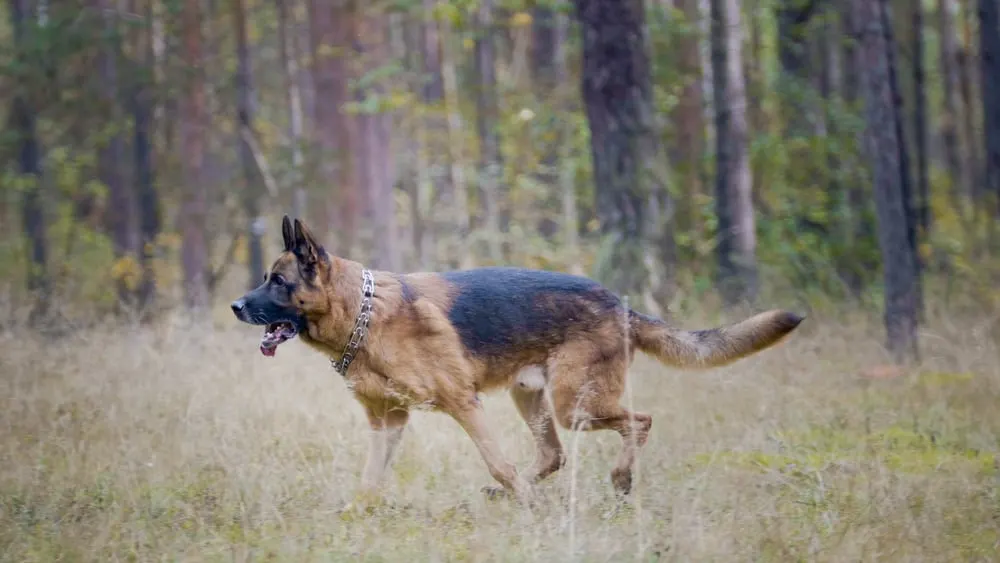
Anal Furunculosis
Anal Furunculosis is a hereditary condition common among German Shepherds. It is a chronic inflammatory disease of the skin that starts under their tail and around their anus. This problem starts when the immune system of the GSD fails to respond properly.
The best way to avoid having a GSD with this hereditary disease is to ensure that your pup comes from GSD parents that are free of Anal Furunculosis genetically.
A report by www.ufaw.org.uk revealed that 84% of reported Anal Furunculosis in the UK in 2004 was with German Shepherd dogs.
Limber Tail Syndrome
Limber Tail Syndrome is also referred to as a cold or broken tail syndrome. When a GSD spends too much time in cold water, it can damage its tail muscles.
The symptoms of Limber Tail Syndrome are swollen tail muscles, cramps, and painful tails. This condition heals after days but if it is causing too much pain, you can ask your vet for a pain reliever.
Skin Infection
Symptoms of skin infection on a German Shepherd’s tail are hair loss and itching. You might notice how your GSD is chewing its tail to curb its itchiness. When scraped and left untreated, it might also lead to infection. If your GSD starts to lick its wound, it might make the cut bigger.
To treat a skin infection, it is best to see a vet immediately. Antibiotic is often prescribed to treat skin infection.
Is Obsessive Tail Chasing Bad for Your German Shepherd?
Do you love seeing your GSD pup chasing its tail? They love loving round and round, trying to chase their tail and when they catch it, they produce that low growling sound.
It means they won. No matter how fun it is watching your pup chasing its tail, the act itself tells something about your pet.
- You will see your GSD catching its tail when it finds itself in a small enclosure. When a GSD is placed in a cramped space, it becomes anxious, hence it catches its tail
- You will see your GSD catching its tail when it is boring. If you haven’t been out with your dog for a day or two, it might need physical activity, and catching its tail is the best activity it might find
When your GSD is bored or anxious, they will end up chasing their tails obsessively until they hurt themselves.
Is Curl Tail Bad for Your German Shepherd?
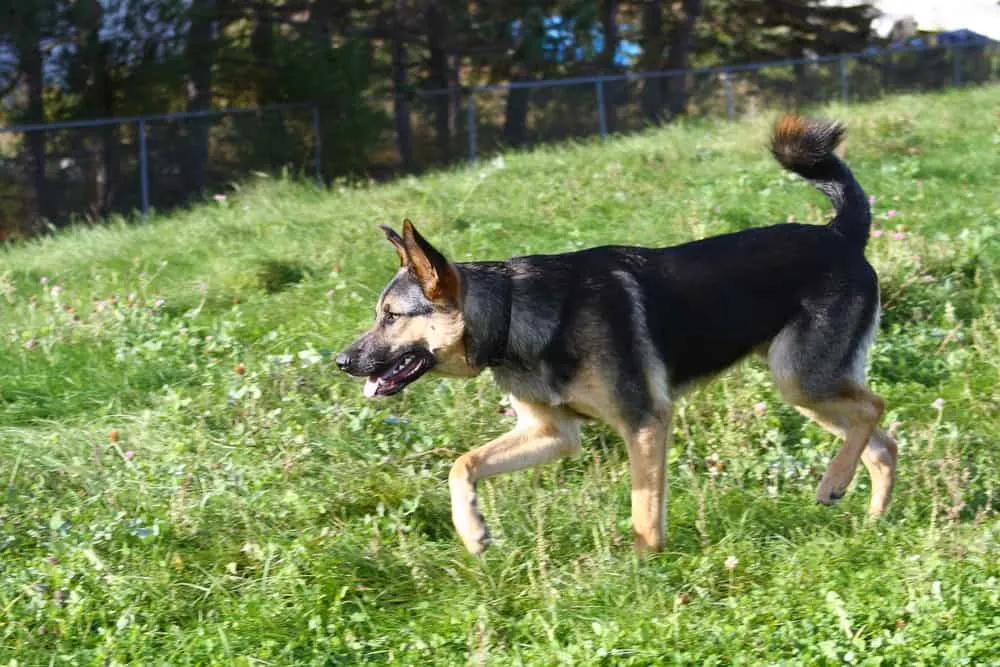
Having a curled tail is not bad for German Shepherds. It is a genetic fault that affected some GSDs. Curled tail is also referred to as ‘gay tail’. This genetic fault can’t be fixed.
Having a gay tail doesn’t affect the health of your GSD. However, some owners prefer a GSD with a straight tail.
A straight tail projects a strong and powerful look that German Shepherds are known for. For this reason, owners of GSDs with gay tails often opt for surgical remedies.
Having your GSD undergo surgery to straighten up a curled tail is not a permanent solution. Because it is hereditary, puppies of a GSD with a gay tail will also have a gay tail even after surgery.
Other Health Concerns for a German Shepherd
Aside from having tail problems, German Shepherds are also prone to developing other hereditary conditions according to iheartdogs.com. Among the common medical conditions that you can expect from a GSD are:
Perianal Fistula – considered as the Crohn’s disease of dogs, this condition affects the anus of the affected dog. It can lead to difficulties defecating, having bloody stool, and itchiness in the surrounding area of the anus.
Dog Bites – German Shepherd are playful and very active. They can easily injure one another, and the tail is one body part that gets bitten easily. Dog bites should be cleaned and treated immediately according to petmd.com.
Megaesophagus – when your GSD starts throwing up especially after eating, it can be a sign of megaesophagus. This condition affects the esophagus, causing it to be limp and unable to pass digested food. It can also cause regurgitation. A GSD with a megaesophagus is often given a soft or liquid diet. Treatment is lifelong.
Hip Dysplasia – This is the most common hereditary medical concern for the German Shepherd. As a large dog, their socket joints are at risk of being malformed. A GSD with hip dysplasia requires lifelong treatment.
Osteoarthritis – Osteoarthritis is common to older GSDs. It happens when they suffer an injury and the injury took a while to heal. One symptom of osteoarthritis is when your dog seems to be slowing down.
Tail-wagging related injuries – German Shepherds are known for wagging their tails all the time. Sometimes, too much enthusiasm can lead to injuries such as banging their tails on furniture or the wall. Tail-wagging accidents can lead to fractured tailbone or cuts and bruises.
Degenerative Myelopathy – as GSDs grow older, they also tend to develop age-related conditions such as Degenerative Myelopathy. This condition affects the spinal cord tissue leading to weaker limbs that can end with paralysis or death.
Fleas – fleas itself is not a medical concern but the effect of having fleas is. Fleas can cause skin infections. A German Shepherd with fleas often suffers skin irritation that leads to irritation, inflammation, and skin infection.
Treating A German Shepherd’s Tail Problem
As a dog parent, you should watch your pet closely. At the first sign of tail problems such as cuts or excessive hair fall, check with your doctor immediately.
If you notice that your dog is biting and trying to scratch its anus consistently, don’t hesitate to check for skin infection or irritation.
Make it a part of your dog’s regular grooming habit. Check its body parts for possible signs of infection or medical condition. Check its head, its toes, and its tail. Thoroughly check its coat and make sure that no fleas are hiding underneath it.
As canna-pet put it, with proper diet and regular grooming and check-up, you can raise a healthy, active, and more fun canine that you can spend your days with for up to 13 years.
Our YouTube Video On German Shepherd Tail Problems
Frequently Asked Questions
Why does my German Shepherd bite his tail?
There are lots of reasons why your German Shepherd might bite their tail. Lots of different breeds do this at different points in their lives, so most of the reasons why your German Shepherd is biting their tail might explain why any breed does this.
One of the most common reasons why German Shepherds bite their tails is because they are playing. Most people will have heard of dogs ‘chasing their tails’, and when they are doing this they often bite their tails. However, you will usually be able to tell if your dog is biting their tail playfully through their behavior.
Your German Shepherd could also be biting their tail because they have fleas or because they are suffering from allergies. German Shepherds are one of the breeds that often suffer from allergies, so if you suspect this to be the cause, then you should speak to your vet.
Do you dock German Shepherd tails?
No, you do not dock German Shepherd tails. This, sometimes controversial, the process is something that should only be done on working dogs as a way to protect them from injury. As German Shepherds are often working dogs, many people expect that their tails should be docked, but this does not need to be done.
The primary breeds that have their tails docked for working purposes are corgis and Aussies. This is done to protect their tail when they are working with heavy livestock, such as cows and oxen. But, German Shepherds only ever work with sheep and smaller animals, like ducks, goats, and geese.
Due to this, there is very little risk of injury to the tail, as the animals that German Shepherds work with are small. Meaning that there is no need to dock their tails.
Why is my German Shepherd’s tail not fluffy?
German Shepherds are well known for being very fluffy, with their tails being one of the most memorable things about them. German shepherd tails are usually big and fluffy, measuring almost as long as the dog’s body. So, if your German Shepherd’s tail is not fluffy, it is understandable that you may be concerned.
One reason why your German Shepherd’s tail might not be fluffy is that they are too young. In a lot of cases, a German Shepherd’s tail will not reach its full fluffiness until the dog reaches maturity at about 1.5 years of age. So before this age, your dog’s tail might be a lot thinner.
If your German Shepherd passes this age, and their tail is still not fluffy, then it is probably due to genetics. Some breed lines of German Shepherds do not have fluffy tails, so it is possible that your dog belongs to one of these lines.
























